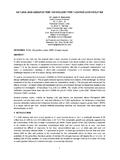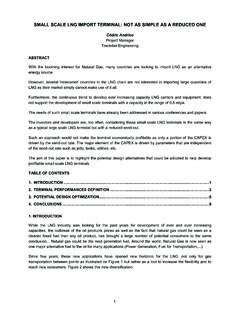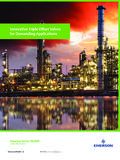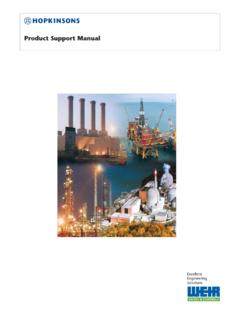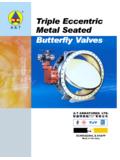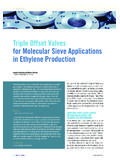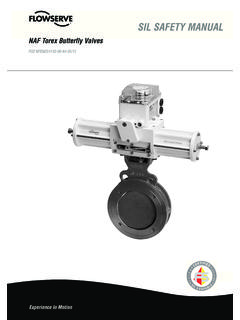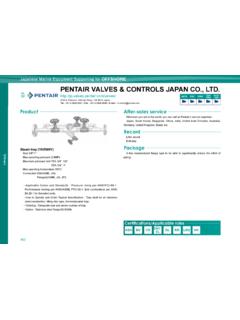Transcription of DEALING WITH THE COLD: A LOOK AT ¼ TURN BALL VALVES …
1 DEALING WITH THE cold : A LOOK AT TURN BALL VALVES AND cold SERVICE DECISIONS. Nathaniel Paxton Mike Wood VALVES & Measurement Group Cameron International Corporation ABSTRACT. What is considered cold for valve applications? Even this is a subjective matter in terms of valve preparedness. One thing is for sure, cold applications these days require more than just a valve handling cold temperatures, which is difficult enough. Cryogenic VALVES are used in a host of applications ranging from liquefaction of dried natural gas, to air separation, to gas [trailer] transport, food processing, and pharmaceuticals, to name a few. Cryogenic VALVES are vital to the proper and efficient operation of these processes. Common issues have been identified that, if understood and addressed in a timely fashion, can help the following: 1. Avoid start-up problems;. 2. Improve the ability of the valve to properly operate, increasing the throughput of the unit 3.
2 Extend the life of the VALVES , saving money in costly, unscheduled repairs 4. Reduce unexpected shutdowns keeping the revenue stream flowing. INTRODUCTION. The study of cold has a rich history. Since the first quarter of the 19th century, many scientists and natural philosophers have taken on its study which has opened up its extraordinary secrets by dispelling many myths. Commercializing on the mastery of these discoveries, life on this planet has never been the same. One has to consider the advancements that have taken place. In the early 1800's, a temperature of -110 C (-166. F) was not proven to even exist. The vocabulary, never mind the means to attain it, did not exist. Through many years of experimentation and the rough road of trying to commercialize on scientific breakthroughs in the marketplace, we enjoy the advancements to human life and the comfort it brings. It has been generally accepted, at least commercially, that the cryogenic temperature range starts at minus -150 C (-238.)
3 F). Certain gases are considered cryogenic because it takes more than just an increase in pressure to compress a volume of gas as stipulated by Robert Boyle. Little did he know at the time (1665) that the relationship between volume and pressure would much later become the cutting edge for cold research. [Absolute Zero and the Conquest of cold , Tom Shachtman,* 1999, Houghton Mifflin Company]. Today, anything warmer than cryogenic temperatures is considered refrigeration, at least for the sake of our discussion at hand. Refrigeration, at one time, was the temperature range required for the preservation of food from 3 C to 5 C (37 F to 41 F). Later on the range went as low as -43 C (-45 F) upon the discovery that fast freezing of food became commercially viable. Later still, the temperature range decreased to -110 C (-166 F) on the onset of non-cryogen liquefaction. This then set the stage for the descent toward the liquefying of cryogens and the descent towards absolute zero.
4 *. 1. Now we get down to the matter of understanding cold as it pertains to the mundane matter of valve selection. There are a number of things we need to understand about cold temperatures when considering how we go about selecting a valve that will work over the long term. What do we have to take into consideration in terms of the physical properties of cryogens themselves and materials that will handle them? The valve industry is conservative. A general rule is that continuous temperatures less than -73 C (-100 F). is considered cold service and warrants valve preparation for cryogenic service. The reasons will be discussed in this paper. There are always exceptions to this rule, as many readers can probably attest, but for the sake of this discussion, that will be the general rule. PROBLEMS ASSOCIATED WITH TRANSPORT OF CRYOGENS. How does one handle the transport of media that does not want to be a liquid at atmospheric pressure from a thermodynamic point of view?
5 It is not easy! Leakage of cryogens is not only dangerous, but also very expensive especially when one considers the cost to make a gas a cryogen in the first place. As it pertains to the valve, it has been said many times that thermal swings can be the Achilles heel for any valve and severe temperature variations of a cryogenic nature take this to a new level. The components of any valve (body, bonnet, stem, stem seals, ball, and seats) will contract and expand at different rates because of different material composition or amount of time exposed to the cryogen. Defining what is Intermittent or steady state service further complicates matters. People tend to take intermittent service less seriously; but thermal growth differences of valve components take its toll which can potentially lead to premature failure. When one considers the seat leakage potential for a turn ball valve, for example, one can readily see that there is bound to be a concern at the ball/seat interface for certain materials.
6 When cryogenic temperatures are involved, the thermal expansion difference between a PTFE (Polytetrafluoroethylene) based seat and a 316 stainless (316 SS) ball is greatly enhanced - to the point where it becomes a design consideration. PTFE expands approximately five times the rate of 316 SS (both are common materials for cold temperatures). What goes together and tests well on the bench is no guarantee of seal tightness in the deep cold where seat geometry and surface finish play a big role. The linear and radial growth of the stem in relation to the body can often be underestimated. Properly designed stems (and stem seals) need to bridge this thermal rate of expansion difference as they are tasked to dynamically seal on the stem outside diameter (OD) and packing chamber inside diameter (ID) at all times. The consequences can be sometimes severe if not problematic. This is described in more detail under Basic Valve Design Objectives.
7 Heat gains from the environment are forever a constant battle when DEALING with cryogens hence the reason for valve and piping insulation. One has to remember what we are DEALING with during gas processing - in terms of the physical properties of gases, such as Liquefied Natural Gas ( LNG which is mostly methane - CH4 ), nitrogen, oxygen, argon, helium, and the like. These liquids' do not want to be liquids at atmospheric pressure and, if allowed, can violently transform to gases in a heartbeat (approximately a 700:1 expansion factor going from liquid to a gas). In the normal processing of cryogens, there is always the buildup of pressure because of this heat gain from the environment and the subsequent vapor formation. There needs to be provisions in the VALVES /piping system to allow for this pressure build up. 2. VALVE CONFIGURATIONS USED IN CRYO SERVICE. While there isn't a rule as to when to use any particular style of valve for cryogenic service, which is typically clean media, it does appear that there is a customer preference for turn motion where tight shut off is concerned.
8 This turn motion is accomplished by use of ball VALVES or high performance/ triple offset butterfly VALVES (TOBV). For large valve sizes, gate VALVES are often utilized. There is a point where triple offset VALVES [TOV] are used because the mass of a ball valve often makes it cost prohibitive above 10 size. There are people who do use ball VALVES in the larger size range it just depends how much one wants to pay up front versus later on in terms of valve performance over time. As for the type of piping connections, flange and welded configurations are used mostly for cryogenic service and it depends on customer preference which type is used. Either of these connection types can handle a wide pressure range; the majority of applications being ASME Class 150 600. Certainly, there are applications for Class 1500 2500. Though not written in stone, ball VALVES are typically used in the 16 range for cryo service, with the majority of the ball VALVES up through 8.
9 High performance / triple offset butterfly VALVES are commonly used in the 10 32 range and, as previously indicated, the 24 56 seems to be the domain of gate VALVES . The marketplace offers different body designs for ball VALVES . For flanged VALVES , an end entry (some refer to this as side entry) uni-body type design is available; where there are no breaks in the valve body that could be considered potential leak paths to the environment. To access the internals, there is a threaded end plug that inserts into one of the flanges. A second option is a split body arrangement where the end plate (sometimes called a tail piece) is bolted to the body. To access the internals, the two components are unbolted. 3. Split body design End entry uni-body body design Three (3) piece body design There are 3 piece body arrangements for ball VALVES , which means a body center section and two end plates (sometimes called pipe ends) that are bolted to the body.
10 The end plate contains the type of connection used in the application some form of welded or threaded connection. This design is popular because the center section can swing out while the valve is in line making the valve in line repairable after it is isolated. As with flanged VALVES for cryo service, a welded extension is fabricated to the body for cryogenic service. Gate VALVES utilize rising stem motion and a bolted bonnet to the body. There are typically no seams or connections in triple offset butterfly valve bodies. These bodies are long or short ISO gate, lug, or wafer configurations. The butterfly face-to-face dimensions are all one-piece castings which are not fabricated from smaller sections. However, a cryogenic design will likely require a welded pipe extension at the top of the body to extend the stem packing, similar to ball or gate VALVES . 4. If a three (3) piece valve is indeed to be welded inline, without first undertaking the recommended disassembly and replacement of soft parts, heat damage to the body seals and seats from the welding process or the post weld heat treatment (PWHT) must be considered.

